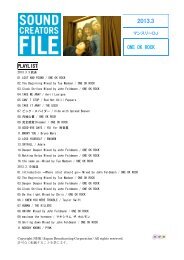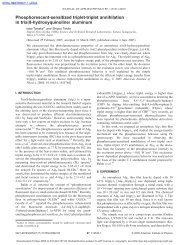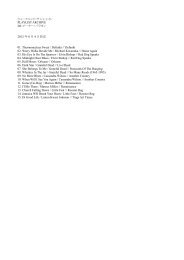Children's Television: Trends Around the World
Children's Television: Trends Around the World
Children's Television: Trends Around the World
You also want an ePaper? Increase the reach of your titles
YUMPU automatically turns print PDFs into web optimized ePapers that Google loves.
CHILDREN’S TELEVISION: TRENDS AROUND THE WORLD<br />
121<br />
sion for preschoolers becomes more widespread, this focus may serve to<br />
shape <strong>the</strong> way youngsters view <strong>the</strong> world from an early age.<br />
Programs that Encourage Children’s Critical Faculties<br />
Pythagora Switch, a program for four-to-six-year-olds that has been running<br />
on NHK Educational since April 2002, has attracted <strong>the</strong> attention of television<br />
producers around <strong>the</strong> world due to its innovation of focusing on “ways of seeing<br />
and thinking.” The aim of <strong>the</strong> program is to translate <strong>the</strong> concept of “<strong>the</strong><br />
way we think” into images. It achieves this aim by means of a creative combination<br />
of animation, puppets, live action, and songs. The program has won<br />
much praise for its success, and it has scooped <strong>the</strong> prizes in its category at <strong>the</strong><br />
Japan Prize International Educational Program Contest, <strong>the</strong> Prix Danube (an<br />
international children’s television contest in Slovakia, launched in 1971) and<br />
<strong>the</strong> Prix Jeunesse International.<br />
The question of how to increase children’s engagement with science is a<br />
much-discussed topic among educators around <strong>the</strong> world. Consequently, <strong>the</strong>re<br />
is great interest in children’s programs that aim to develop a scientific way of<br />
looking at <strong>the</strong> world around us. PEEP and <strong>the</strong> Big Wide <strong>World</strong>, produced by<br />
American public television broadcaster WGBH with o<strong>the</strong>r producers, is one<br />
such program. Each episode explores a scientific topic, such as gravity or <strong>the</strong><br />
ecology of an animal, by means of animated stories depicting <strong>the</strong> adventures<br />
of a chick, PEEP, interspersed with live-action segments showing children<br />
playing and experimenting with <strong>the</strong> concepts introduced by PEEP.<br />
Programs that Encourage Children’s Physical Activity<br />
In addition to <strong>the</strong> programs encouraging creative thought in children, programs<br />
encouraging creative physical activity are also appearing. Boohbah, by<br />
<strong>the</strong> producers of Teletubbies (see below), is a 20-minute program for three-tosix-year-olds<br />
that aims to stimulate both creative thought and physical activity.<br />
The program centers around five sparkling characters—“Boohbahs”—who<br />
radiate a bright and powerful energy that sends <strong>the</strong>m whirling and dancing<br />
around. They invoke an irresistible desire in children to join in and dance<br />
about. The story portion of <strong>the</strong> program always includes problem-solving of<br />
some kind. The viewers’ creative thought is encouraged through <strong>the</strong> fun of<br />
guessing how <strong>the</strong> story is going to evolve. Boohbah was launched by a commercial<br />
broadcaster in <strong>the</strong> United Kingdom in April 2003, and now shows<br />
around <strong>the</strong> world, including North America, Australia, South Africa and<br />
Israel. In fall 2004, <strong>the</strong> BBC launched a new program encouraging physical<br />
activity in children: Boogie Beebies, which uses specially commissioned pop







